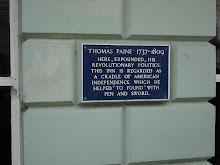
The Bugatti family were certainly a talented bunch. Carlo, the patriach was a designer of extraordinary furniture and jewellery whilst sons Rembrandt and Ettore were sculptor and automobile designer/manufacturer respectively. The picture taken at the HQ of the Bugatti Trust at Prescott near Cheltenham shows the radiator of one of the world's largest and rarest cars, the Bugatti Royale. Truly a leviathan, the 12.7 litre cars of which only six were built were a bit of a white elephant for Bugatti and he found them difficult to sell, even to the super rich of the day. Powered by an exquisitely sculpted and engineered motor it had but three speeds in its rear-axle gearbox of which top was only really necessary. Despite the size it looks perfectly proportioned in the metal with wonderful detail touches such as hand scraped finishes to the engine castings and sublime (and enormous) cast aluminium wheels. This example is now owned by the current Bugatti manufacturers, Volkswagen and is maintained by English specialists. The nice touch of using an elephant as a radiator mascot was, I like to think a touching memorial to Ettore's brother Rembrandt whose work it is - poor Rembrandt took his own life in 1916 at the age of 31. Ettore Bugatti was quite an extraordinary man and ran his factory from a chateau at Molsheim where he could also indulge his love of fine horses and carriage driving. His automobiles, among them the beautiful Type35 racing car were known as 'Pur Sang' or 'pure blood' just like his nags. The adoption of the eliptical logo with a capital 'E' reversed and conjoined with a 'B' over the name Bugatti on a red ground is iconic, and to carry the equine theme through, most Bugatti radiators were horseshoe-shaped; simple, distinctive and beautifully made of German silver. If ever an automobile designer got it right, it was Bugatti. The smallest details like bolts manufactured with their own distinctive built-in washers, were his trademark. Ever resourceful and pragmatic, the manufacturing capability was there for The Royale, so he built more engines and created innovative railcars for the French government. These were in use up until the war setting speed records along the way and utilised four of the mighty Royale engines...what I would have given to have stood next to a fast stretch of line to hear one go by on its open exhausts. After the death of his beloved son Jean, Bugatti carried on with many projects, working on new designs throughout the second world war and indeed created the exact opposite of the Royale in the Type 72, a 12.6cc supercharged cyclemotor designed for use in post-war austerity France...like it's big brother it never caught on. No detail was too small to escape 'Le Patron's' eye from the hinges on the doors at Molsheim to the design of carriage harness, to his clothes. I give you Ettore Bugatti - a jolly clever man.

